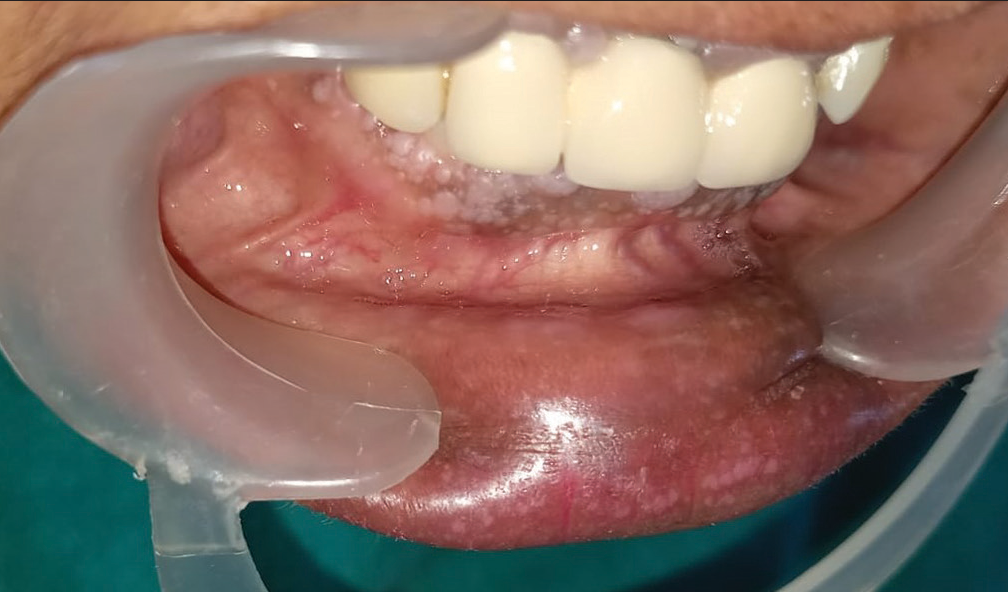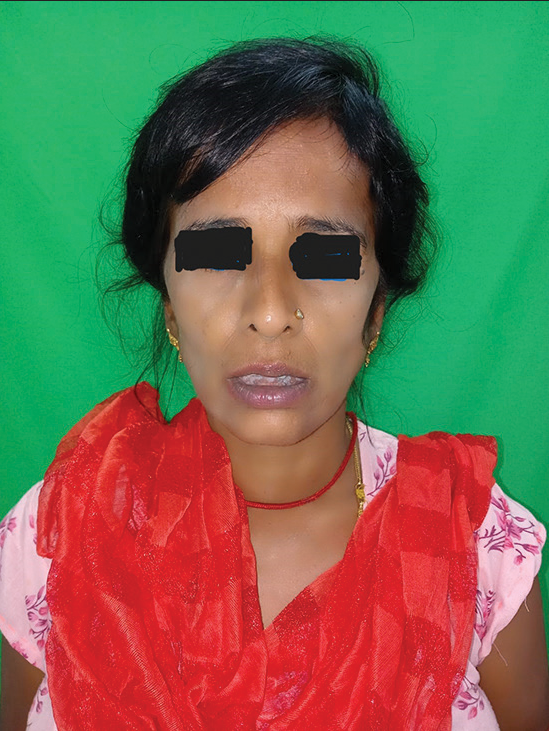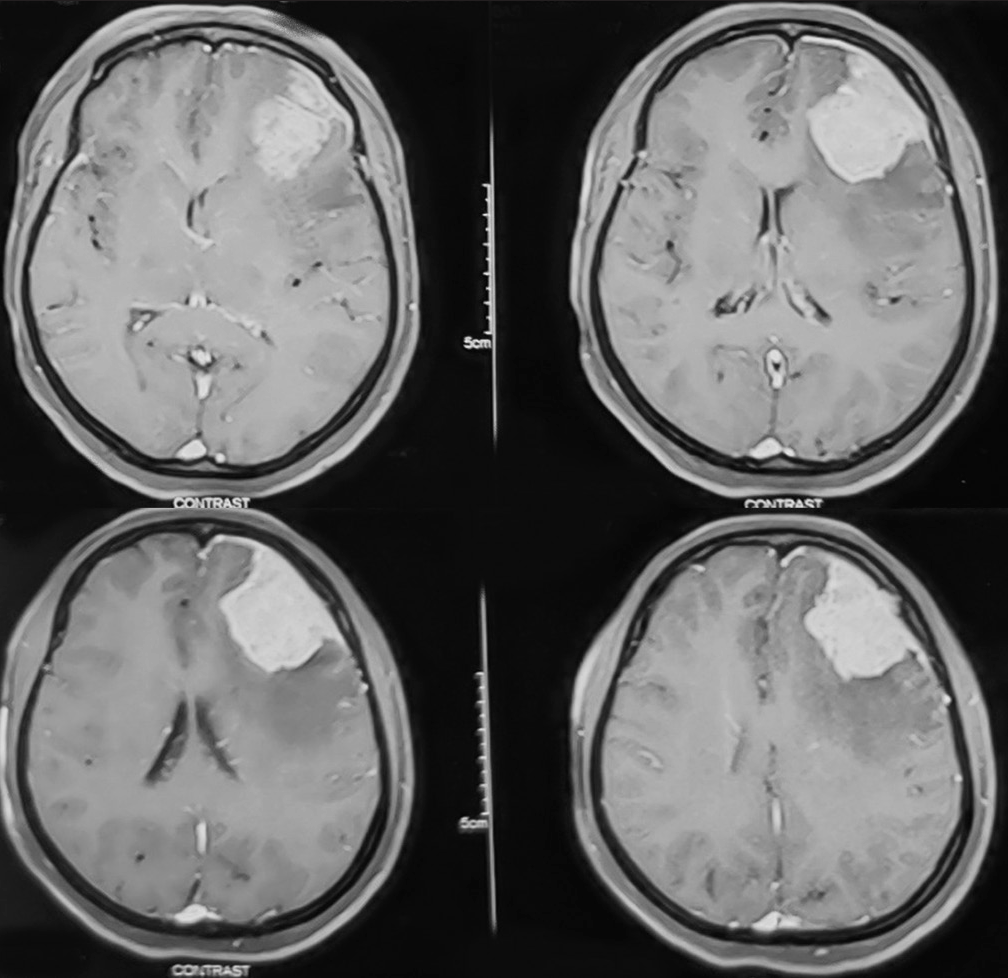Translate this page into:
Meningioma getting a common presentation in uncommon Cowden syndrome: A case report
*Corresponding author: Ashis Patnaik, Department of Neurosurgery, AIIMS, Bhubaneswar, Odisha, India. neurosurg_ashish@aiimsbhubaneswar.edu.in
-
Received: ,
Accepted: ,
How to cite this article: Patnaik A, Pattnaik N, Sekar A, Singh DK. Meningioma getting a common presentation in uncommon Cowden syndrome: A case report. J Neurosci Rural Pract 2023;14:756-8.
Dear Editor,
Cowden syndrome (CS) is a rare autosomal dominant syndrome characterized by hamartomatous growths, which can increase the risk of developing both benign and malignant tumors within affected families.[1] It belongs to the phosphatase and tensin (PTEN) hamartoma tumor syndrome group and caused due to heterozygous mutation in the PTEN gene in chromosome 10q23.[2] It is a multisystem disorder whose diagnosis is usually based on the positive objective findings only. Clinically, CS is characterized by mucocutaneous lesions, goiter, and gastrointestinal polyps along with cancers such as breast cancer, thyroid cancer, and endometrial cancer. Although meningiomas have not been included in the diagnostic criteria for CS, they have been reported to be strongly associated with it in few articles. There has been demand for meningiomas with brain tumors to be included in the diagnostic criteria of CS. We present a rare case of CS with oral manifestations with meningioma in the brain in a patient treated for endometrial carcinoma.
A 39-year-old female patient presented with missing teeth and bleeding gums. Extraoral examination revealed macrocephaly. She gave a positive history of severe headache for the past 8 months which gets worse during the morning. Her previous medical reports revealed that she was having endometrial carcinoma confirmed through biopsy. She underwent a hysterectomy and completed brachytherapy and now on active surveillance for any recurrence. On examining her oral cavity, the gingiva had multiple papules, which gave an appearance of a cobblestone [Figure 1]. In addition, papular lesions were also observed on the upper and lower labial mucosa [Figure 2]. She had multiple missing teeth with the presence of plaques and calculi. A provisional diagnosis of chronic generalized gingivitis with a partially edentulous ridge was made. Incisional biopsy suggested the presence of inflammatory gingival hyperplasia. She had comparatively a large head which on measurement showed the occipitofrontal circumference to be 59 cm confirming macrocephaly [Figure 3]. She was referred for physician consultation for her headache. Computed tomography and magnetic resonance imaging brain showed an extra-axial homogenously enhancing lesion in the right frontal region suggestive of meningioma [Figure 4]. Based on the patient’s medical history, clinical presentation, and biopsy results, a diagnosis of CS was ultimately established. Further, she underwent treatment for meningioma in the form of craniotomy and complete excision of meningioma (Simpsons grade I excision). Histopathology of the excised specimen was suggestive of fibrous meningiomas World Health Organization grade I.

- Intra-oral picture showing cobblestone appearance on gingiva.

- Intra-oral picture showing cobblestone appearance on the lower labial mucosa.

- Macrocephaly with head-on measurement showing the occipitofrontal circumference to be 59 cm.

- Magnetic resonance imaging brain showing an extra-axial homogenously enhancing lesion in the right frontal region suggestive of meningioma.
PTEN is a tumor suppressor gene that downregulates the PI3K/AKT/mTOR growth-promoting signaling pathway.[2] Dysfunction of this gene in CS causes dysregulation of this signaling and other pathways, resulting in overgrowth or hamartomas. Cutaneous lesions are one of the important diagnostic criteria to this syndrome. These include trichilemmomas in the perioral areas and nasal, acral keratosis involving hands and papular lesions on the lips and oral mucosa, which collectively give rise to a distinct cobblestone appearance. It is estimated that approximately 90% of CS patients exhibit these characteristic features.[3] Typically macrocephaly is found in over 80% and thyroid, breast lesions in 75% of all cases.[2]
Due to varied clinical presentations, establishing a diagnosis of CS can be quite challenging. Genetic testing is not feasible due to the complex heterogeneous features of the syndrome as well as the large number of suspect cases. There is a standardized scoring system to diagnose the syndrome on a clinical basis called Cleveland clinic adult clinical scoring system. International Cowden Consortium has given a list of criteria to diagnose CS.[4] Although Lehrmitte-Duclos disease has been a major criteria in CS, meningiomas and other brain tumors have not been included even as a minor criteria. As meningiomas have been reported in as many as 8% or CS, it should find a place in the diagnostic criteria of the syndrome. Yakubov et al. in their meta-analysis of 109 patients of CS with confirmed PTEN mutation found the incidence of associated meningioma to be 8.25%.[1] Pain et al.[5] and Aggarwal et al.[6] have reported multiple meningiomas in cases of CS.
Once the diagnosis of CS has been established, the patients need active surveillance to detect early cancer development and their management. As the genomic alteration of both CS and meningiomas resides in chromosome 10, there seems causative relationship between the two which is also supported by published literature. Hence, inclusion of meningiomas in the diagnostic criteria of CS will help increasing the awareness of CS among the neurosurgical community and thereby detecting the familial multiple cancer syndrome of Cowden at an early stage.
Declaration of patient consent
The authors certify that they have obtained all appropriate patient consent.
Conflicts of interest
There are no conflicts of interest.
Use of artificial intelligence (AI)-assisted technology for manuscript preparation
The authors confirm that there was no use of artificial intelligence (AI)-assisted technology for assisting in the writing or editing of the manuscript and no images were manipulated using AI.
Financial support and sponsorship
Nil.
References
- Hidden association of Cowden syndrome, PTEN mutation and meningioma frequency. Oncoscience. 2016;3:149-55.
- [CrossRef] [PubMed] [Google Scholar]
- Managing the risk of cancer in Cowden syndrome: A case report. J Med Case Rep. 2012;6:225.
- [CrossRef] [PubMed] [Google Scholar]
- Cowden syndrome: A critical review of the clinical literature. J Genet Couns. 2009;18:13-27.
- [CrossRef] [PubMed] [Google Scholar]
- Genetic/familial high-risk assessment: Breast and ovarian, version 1.2014. J Natl Compr Canc Netw. 2014;12:1326-38.
- [CrossRef] [PubMed] [Google Scholar]
- Multiple meningiomas in a patient with Cowden syndrome. J Neurol Surg Rep. 2016;77:e128-33.
- [CrossRef] [PubMed] [Google Scholar]





